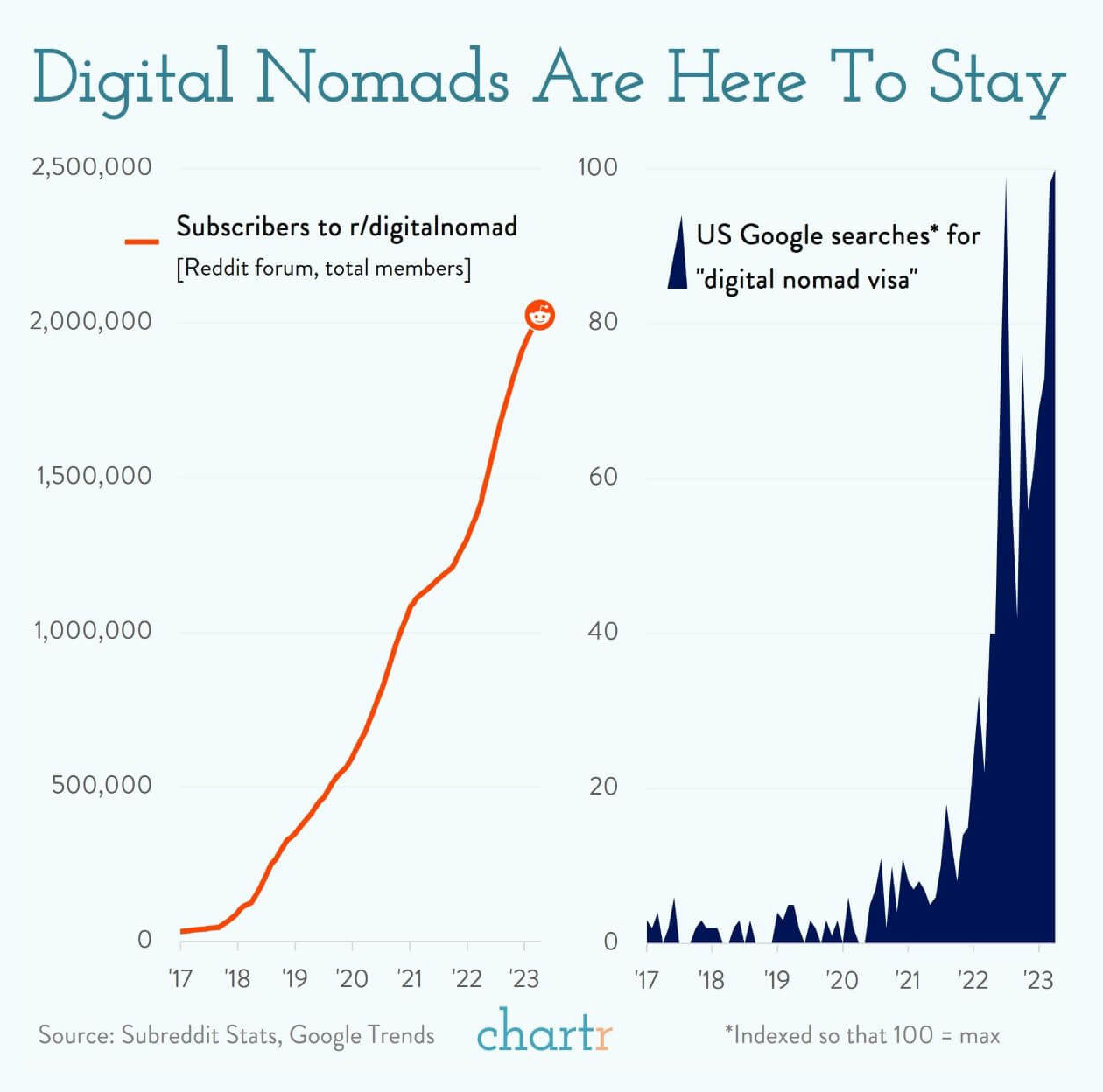The 5 Types of Digital Nomads: Which One Are You?

What is a digital nomad?
It may seem like an odd question, but in a post-pandemic world where remote work is mainstream, it's actually a VERY important one.
The answer will help shape future laws around travel, work, and taxation.
Prior to 2020, the term digital nomad was used pretty loosely. It was a small niche community of people and it did not require a strong definition.
However, as the number of digital nomads has grown exponentially post-pandemic, governments have started paying closer attention to the movement as a way to increase tax revenue and plug talent gaps.
But how can governments create laws for something they don't have a definition for?
There's no better example of this than the emergence of the "digital nomad visa". Currently, there are around 50 countries that have launched digital nomad visas, but you would be hard-pressed to find one that is actually designed with nomads in mind.
Most of them are actually visas for remote workers that kickstart the immigration process.
Hardly a product for what we would normally define as a digital nomad.
Why We Need to Define What a Digital Nomad Is
If we want to help governments come up with regulations & programs for digital nomads we need to help them define what a digital nomad actually is.
Furthermore, we need to be able to accurately segment digital nomads, since not all people who identify as digital nomads currently exhibit the same behaviors in terms of work & travel.
Dave Cook is an anthropologist, consultant, and researcher at the University College London where he has spent the last 7 years studying the digital nomad movement and has come up with the following definition...
Based on his research, and the research of several other firms, he has separated digital nomads into 5 different groups based on their relationship to work:
- Freelance digital nomad
- Digital nomad business owner
- Salaried digital nomad
- Experimental digital nomad
- Armchair digital nomad
In addition, Cook also identified 6 "variable themes" which can be laid on top of the 5 groups for further segmentation:
- autonomy vs mobility (control over where you live vs travel)
- homebase practices
- domestic vs transnational
- legal legitimacy (using nomad visas, or in the gray area of tourist visas)
- work-life balance vs work-life integration
- coworking usage
Let's dive in...
1. Freelance digital nomad
Historically this is the most common type of digital nomad. It's also the one that has been studied for the longest time and is thus used for historical data regarding the digital nomad movement.
A freelancer as defined in this research is someone who does not have a full-time job and has not built a full-scale business which includes hiring other people and having more complex business systems.
Freelance digital nomads exist somewhere in between. They have complete control over their location since they don't have a boss, and trade their time for money working for 2 or more clients.
Research among this group points to a slowing travel trend, with most visiting 3-5 locations in one year.
It seems that digital nomads travel rather quickly, jumping from destination to destination for the first 2 years, then the travel slows down.
Pieter Levels the founder of NomadList echos these findings. From his experience most new digital nomads travel fast at first, and then begin traveling more slowly usually going between locations they already know and like.
2. Digital nomad business owners
These digital nomads run more established businesses that may have staff, a team of contractors, or product inventory all of which require more complex business systems and legal entities.
Digital nomad business owners travel less than their freelancer counterparts, most likely because of more intense work commitments.
However, researchers have found that the separation between nomadic business owners and nomadic freelancers is "porous".
The idea of a personal brand has gained traction and more and more people view themselves as a business. So, while freelancers don't normally qualify as a business, they can easily move in between these two categories.
3. Salaried digital nomads
Historically this was a tiny group of people in comparison to the larger digital nomad movement, however, its exploded since the pandemic.
MBO Partners is a workforce management platform that ran a large digital nomad study in 2022 in the US and found that the number of salaried digital nomads doubled in 2020, and then grew an additional 41% in 2021.
According to MBO, there are around 11.1 million salaried digital nomads in the US alone!
Not only does this make salaried digital nomads the fastest-growing group of digital nomads, but in a few years it will very likely be the largest group.
As this group of digital nomads continues to grow it presents some interesting questions related to how knowledge workers work:
- How will these people vacation? What sort of impact could this have on the tourism industry?
- What sort of taxation liability will they introduce to their companies and what kind of services need to be created to answer this?
- How will they affect the idea of the 9-5, Monday to Friday work routine?
Unlike the freelance and business owner digital nomad, a salaried digital nomad is part of a much larger network and this will naturally send shock waves throughout the business community.
For example, it could heighten workplace tension as some companies, like Airbnb, embrace digital nomads, while others like Disney, reject it and force people back into the office.
As Raj Choudhury, a decorated Harvard Business economist said in an interview with Wired: "There are two kinds of companies. One is going to embrace work-from-anywhere and the second is in denial."
4. Experimental digital nomads
These digital nomads can be defined as testing out the lifestyle, but not yet earning money.
What separates them from regular tourists or backpackers is that they frame their day-to-day life with work, and not travel.
They will still lead similar lives to other digital nomads and frequent cafes or coworking spaces but do not yet have a way of generating income online.
Research shows that a high percentage of these experimental digital nomads will actually give up on lifestyle within the first year and return to their hometowns.
The people who crack the code will fall into one of the previous 3 groups.
5. Armchair nomads
Along with salaried digital nomads, the armchair nomads are perhaps the most important group to the future of the movement.
Armchair nomads are people who are interested in the lifestyle and plan on becoming nomadic within the next 2 to 3 years. What's perhaps most shocking about this group is how big it is...
MBO estimates that there are around 72 million armchair nomads in the US alone!
The big question about this segment of digital nomads is how many of them will actually become digital nomads.
The conversion rate here does not have to be large to have a huge impact, as Steve King, the lead researcher for MBO put it: "Even if it is 5% over the next couple of years, that would be three and a half million. That’s a big chunk.”
More importantly, however, is that this group points to just how mainstream the digital nomad movement has become. This is well illustrated by a recent Chartr analysis of the rising popularity of the r/digitalnomad subreddit and the number of Google searches for "digital nomad visa":

Before 2020, if you said you were a digital nomad most people would look at you with blank stares.
The odds are that today they would not only know what that means, but they may even know someone who identifies as a digital nomad.
That's a dramatic change in just 3 years.
The 6 Digital Nomad Variables
While the 5 groups we just outlined do a good job of placing people into groups based on their relationship to work, there are 6 additional frames through which Cook says you can further segment digital nomads.
1. Autonomy vs mobility
For many digital nomads, self-autonomy, the ability to have complete control over your life and choices like where you live or what you do on a day-to-day basis, is a core belief.
While autonomy and mobility are closely linked, they are very much separate. One digital nomad could have high personal autonomy because they run an online business but travel very little, while another may travel much more frequently but have less autonomy because they work for a company.
2. Homebase practices
Ina Reichenberger, a professor at the Victoria University of Wellington, created a 4-point scoring system, from 0 to 3, for digital nomads based on their relationship to a fixed residency.
0 - works remotely from home
1 - works remotely but not always from a designated home office
2 - constant work and travel, but has a homebase
3 - constant work and travel with no permanent residence
While people in categories 0 and 1 do not fit the definition of a digital nomad, those who fit into categories 2 and 3 are digital nomads but one has a permanent home base they may return to throughout the year, while the other has no attachment to any location.
3. Domestic vs transnational travel
While most digital nomad research & coverage focuses on people who travel between different countries, there is a growing number of digital nomads who travel within a country.
The growing popularity of this domestic digital nomad correlates with the growth of the salaried digital nomad. This makes sense since some companies may not care where you work as long as it's within a specific country.
Domestic nomadism is most common in large countries such as the United States, Canada, Australia, China, and Russia where you can travel vast distances without ever crossing an international border.
4. Legal legitimacy
While this is not a large differentiator at the moment it will likely become one as governments continue to introduce more and more legislation focused on digital nomads.
This will divide digital nomads into two camps, those who are in a country through a government scheme, and those who are in the gray area of working remotely from a country on a regular tourist visa.
5. Work-life balance vs work-life integration
Both of these practices have the common origin of having a better lifestyle in the context of work, but where one camp tries to create boundaries between work and life in search of a better balance, the other believes that that's not possible.
Those who seek work-life integration try to naturally fuse their work with their life and will often have shorter work days but skip weekends, or lead a nonlinear workday where, for example, they work early in the morning, a few hours at lunch, and then another work block after dinner.
6. Coworking usage
Since the popularization of the digital nomad lifestyle in the late 2000s coworking spaces emerged as dedicated places where digital nomads could get the benefits of an office without the downsides.
They could work from a comfortable chair with fast wifi and work around other people reducing the feeling of loneliness.
Digital nomads can often be split between those who seek out coworking spaces and those who instead choose to work from their living accommodations or coffee shops.
The Missing Variable - Nomadic Families
The digital nomad movement has needed further segmentation for years, and this is a strong start, but I feel that one of the key parts of the movement is overlooked with this proposed "taxonomy" - nomadic families.
While a large majority of digital nomads are singles, the number of families that are fully nomadic, or flex into a nomadic lifestyle for a few months out of the year is growing quickly.
Boundless Life, an education service for nomadic families, has seen massive growth since launching in 2021.
In April of 2023, they saw the largest cohort of families ever: 51 families, with 96 kids, across 3 different destinations in Portugal, Greece, and Italy

The interesting question for researchers is how many of those 72 million Armchair Nomads are actually part of a family?
Researchers need to pay special attention to this group since kids who grow up in a nomadic setting would have a very different outlook and relationship with the world.
What incredible things will these kids create when they grow up?
This Is Only The Begining For Digital Nomads
Despite recent headlines dominated by CEOs forcing employees back to the office, the digital nomad movement is not only alive and well, but it's just getting started.
We will need to pay special attention to digital nomads over the next decade as the movement matures and newer segments emerge...
How many armchair nomads will convert into full-blown digital nomads? Will salaried digital nomads travel continuously or split their time between the road and a home base? How will geopolitical changes and wars affect the popularity of digital nomadism?
For those of us that have identified as digital nomads for years, it may seem like it's nothing new, but a vast majority of the world is just waking up to the lifestyle's potential.
And things are about to get very interesting...
